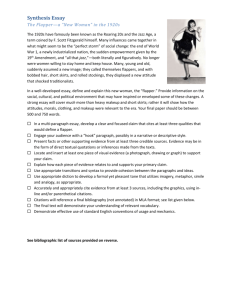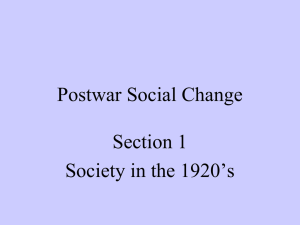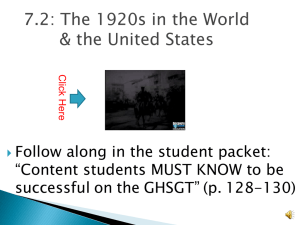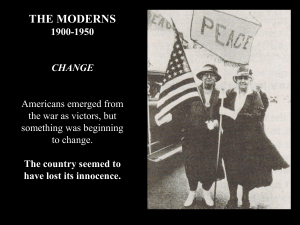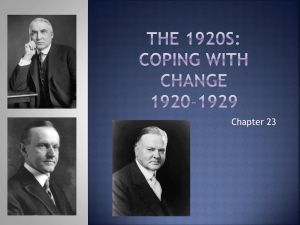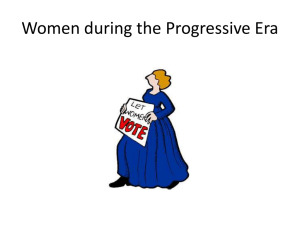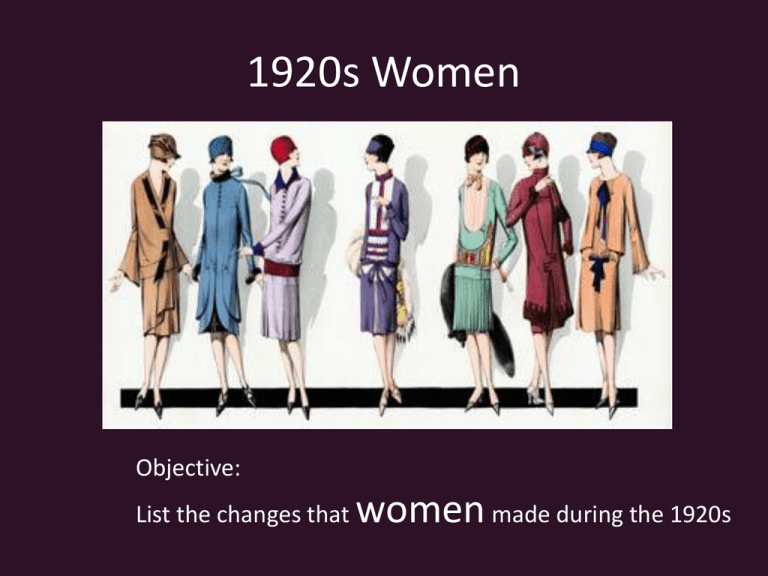
1920s Women
Objective:
List the changes that
women made during the 1920s
Importance
• Which strategy was not employed by women
suffragists to obtain their goal?
– 1. They called for female workers to strike.
– 2. They advocated a constitutional amendment.
– 3. They tested the Fourteenth Amendment in
court.
– 4. They convinced state legislatures to grant
women the right to vote.
Vocab
• Traditonal
– characteristic of the older style
• Restrictive
– limitation of application, as terms, expressions
• Suffrage
– the right to vote, esp. in a political election
• 19th Amendment
– citizens of the United States to vote shall not be denied or abridged by
the United States or by any State on account of sex
• Liberate
– to free (a group or individual) from social or economic constraints or
discrimination
• Double Standard
– different provisions for one group of people than for another
• Flapper
– a young woman, esp. one who, during the 1920s, behaved and dressed
in a boldly unconventional manner.
Major Themes
•
•
•
•
•
1.) Traditional roles of women
2.) Women Before World War One
3.) Women’s Rights (19th Amendment)
4.) Women After World War One
5.) Women and the 1920s
Women’s Traditional Roles
• 1.) Family Focus
• Wife
• Mother
• 2.) Education not
priority
• 3.) No political
power
Women Before World War One
• 1.) Few Job Opportunities
• Examples: Maid, seamstress
• 2.) Restrictive Life
• No job=no money
• Limited education
• Under power of husband (Coverture Law)
• No political rights (not vote)
• No societal rights: not smoke in public, proper
behavior, if dated be chaperoned.
• Dress: RESTRICTIVE! No make-up or pants,
dresses only, cage-like corsets.
Examples of Restrictive Clothing
The Causes for Women’s Rights
1.) Post Civil War
-13th, 14th, 15th Amendments focused on
African-Americans.
-15th Amendment gave ex-slaves the right to
vote (1868)
- Voting Rights belonged to men only.
- Women begin to rally for their rights.
-Wanted Suffrage (the right to vote).
Causes continued…
• 2. ) Women Suffrage Movement
• Suffrage: right to vote
• 1848-1920 (70 years)
• Seneca Falls Convention 1848: First
meeting organized by women for their
voting rights.
• Got women the right to vote.
Key Women Suffragists
• 1.) Susan B. Anthony
– Involved in Progressive
Movement (reform
immigrants and poor)
– Rallied for Women’s
Rights.
Suffragists continued…
• 2.) Elizabeth Cady
Stanton
• Organized rallies and
wrote speeches for
women’s rights.
– Campaigned for
women’s rights.
Women Campaigning for Votes
19th Amendment
• The 19th Amendment was passed in 1920.
• The 19th Amendment gave women the right to
vote.
• 19th Amendment was the result of Women
Suffragists.
Effects of 19th Amendment
• Liberated women (freed women)
• Women had political power
• Women began to liberate themselves in
society
• The start of the modern women
• The flapper of the 1920s
WOMEN AND THEIR RIGHT TO VOTE!!!
19th Amendment (1920) marked greatest change made in
voting history
• Ignorance/lack of interest of their right to vote and male
domination kept many women away from polls (35%1920)
• 11% of women did not think they should have
the right
• Rather than crusading for social progress young
women concentrated on individual selfexpression
Women After World War One
• Women had voting rights
• Women worked as a result of World War One
– Job experience
•
•
•
•
Women were financially independent
Double Standard
Marriage rights (right to a divorce)
Change in behavior:
– Young women were rebellious: cut hair and wore
daring clothing
– Smoked in public and wore make-up!
– Media portrayed women as “sex symbols”
Beginning of the modern women
A new modern woman emerges…
The Flapper
A rebellious BOLD woman…Smoke “devils
weed”, drank, short hair, thin, flat chest, skirts
above the knee, makeup, talked openly about sex
MEN FLOCKED TO the new Flapper
Lasting effect on today’s America
Women and the 1920s
Flapper
What is the difference in fashion between the flapper and the women on
the right?
Why do you think the older generation was upset by this new fashion
trend?
A group of women were at the forefront of
the “fun” movement. They were called
flappers. Flappers were characterized by the
following traits:
• Short hair and short skirt
•Makeup (Oh No!)
• Turned down hose and powdered knees?
• Drinking, smoking, and cursing
Why do you think these traits offended some
of the older generation?
The Flapper
• Definition: rebellious
young women embraced
the urban attitudes and
fashion of 1920s.
• Fashion: make-up, short
hair, short skirts, drank
and smoked.
• Reckless behavior
• Called flapper because of
Charleston dance.
“The Flapper”
By Dorothy Parker
The playful flapper here we see,
The usual dancing men.
The fairest of the fair.
Her speed is great, but her
control
She’s not what Grandma used to be,
You might say, au contraire.
Her girlish ways may make a stir,
Her manners cause a scene,
But there is no more harm in her
Is something else again.
All spotlights focus on her
pranks.
All tongues her prowess herald.
Than in a submarine.
For which she well may render
thanks
She nightly knocks for many a goal
To God and Scott Fitzgerald.
Her golden rule is plain enough
–
Just get them young and treat
them rough.
Definition of a Flapper
“Flapper” first started in Great Britain after WWI. It was used to describe young girls that were
awkward and have not yet entered womanhood. Author F. Scott Fitzgerald describes flappers as
“Lovely, expensive and about 19”. He drew the girls wearing unbuckled galoshes that made a
“flapping” noise when they walked.
The Dictionary of Word and Phrase Origins describes a flapper as a “Giddy, attractive, slightly
unconventional, somewhat foolish girl full of wild surmises and inclined to revolt against the
precepts and admonitions of her elders”.
Flappers had the image and the
attitude to match.
History1900s.about.com/od/1920s/a/flappers.htm
Life of a Flapper
The life of a flapper was a lot of fun!
It consisted of constant partying.
Flappers smoked cigarettes and drank
alcohol – all of which were unheard of if
you were a woman!
They lived very reckless lives and would
cling to their youth.
Flappers were the first of the women to
flaunt their sexuality.
Their lifestyles were shown in the way
that they dressed and danced.
The Flapper Look
Flappers were the first to show off and get
a little crazy in terms of fashion. They wore
heavy make up with scarlet lips and heavy
eye make up. Before the flappers, only
“loose” women wore make up.
Women tried to look more like men
in the twenties. They would tightly
wrap their chest with strips of cloth
to flatten it. They were trying to look
around the age of a 15 year old boy.
Their clothes were a lot different than
those of the past. They usually wore a
dress that went just below the knee,
stockings, heels and step ins (a one piece
suit that was used as underwear instead of
a corset).
“The tube” was a fashion icon. This
was when fashion focused less on
the physical form. The hemlines
dropped to the knees and the
hiplines were lowered. The “Tube”
look was straight from the shoulders
to the hem.
The look was created by Coco Chanel (the
world famous Chanel that we have now)
and it was all the rage.
The Flapper Look
Part Two
The twenties changed the way the world looked at
hair styles. “The Bob” is the infamous hair style that
was everywhere in the 20’s.
Most women haircuts were
very short in the back and 20
% longer in the front.
The Cloche Hat was a must during the day.
This was a hat that fit snuggly over short
hair and reached the eyebrows.
www.clarabow.net
Entertainment
Drinking
Drinking was a favorite pastime of
the flappers. Prohibition was in
effect, and the women were
breaking the law. Before this, only
men would drink. The women
were seen as “Giddy Flappers”
due to drunkenness.
Many carried a flask, which was
extremely unheard of – even for
men!
www.silentladies.com
Entertainment
Dancing
Dancing was a flappers
favorite pastime. They
would dance the
Charleston, Black Bottom
and the Shimmy.
The May 1920 edition of
Atlantic Monthly said that
“flappers trot like foxes,
limp like lame ducks, one
step like cripples, and all
the barbaric lawp of
strange instruments which
transform the whole scene
into a moving picture of a
fancy ball in bedliam”.
“In the 1920’s, a new woman was born. She smoked, drank, danced and voted.
She cut her hair, wore make-up, and went to petting parties. She was giddy and
took risks. She was a flapper.”
History1900s.about.com/od/1920s/a/flappers.htm
Famous Flappers
Anita Page
Colleen Moore
Louise Brooks
www.silentladies.com
Flappers got their name from a new dance craze called
the Charleston, which required the dancers to flap their
limbs erratically. The music of choice for this era was a
new type of music called Jazz. Jazz was very popular
among young people, but the older generation was
getting nervous with the new styles.
From the Ladies Home Journal
Does Jazz Put the Sin in Syncopation? by Anne Shaw
Faulkner
Jazz originally was the accompaniment of the voodoo
dancer, stimulating the half-crazed barbarian to the vilest
deeds. The weird chant, accompanied by the syncopated
rhythm of the voodoo invokers, has also been employed
by other barbaric people to stimulate brutality and
sensuality. That it has a demoralizing effect upon the
human brain has been demonstrated by many scientists
Limitations and Exceptions
• Women were still paid less than men,
– even when they did the same job.
• In politics, women didn’t achieve equality
– Only a handful of women had been elected by 1929.
• Strong conservative tradition in USA.
– Combination of traditional religion & old country
values
– Kept American women in a much more restricted role.
• “Most middle class women concentrated on
managing the home…Their daughters…were far
more likely to prepare for careers as mothers and
housewives.”
Conclusion
• Young middle class women in the cities – the flappers
– experienced massive changes to roles in American society.
• Majority of women experienced minor changes
– Lives remained very similar to how they had been before
the war.
• Some women “more traditional rural areas”
– outraged by the actions of the flappers in the cities
– opposed many of the images of women in films, novels
and magazines.
Importance
• Which strategy was not employed by women
suffragists to obtain their goal?
– 1. They called for female workers to strike.
– 2. They advocated a constitutional amendment.
– 3. They tested the Fourteenth Amendment in
court.
– 4. They convinced state legislatures to grant
women the right to vote.
Closure
• During World War I, the American women's
movement was strengthened when women
– 1. joined the army and fought alongside men.
– 2. stayed at home and ran the households.
– 3. took over hundreds of jobs that men left.
– 4. formed their own political parties.
Closure
• "Double standard" refers to
– 1. stricter social and moral standards for women
than for men in the 1920s.
– 2. owner wages women earned compared to
those earned by men in the 1920s.
– 3. amount of work that women did both at home
and outside the house in the 1920s.
– 4. unfair treatment of women in the workplace in
the 1920s.
Closure
• A study of the "flappers" of the 1920’s would
indicate that
– 1. some women rejected traditional feminine
roles.
– 2. many women were elected to national political
office.
– 3. women were fired from traditionally male
occupations.
– 4. the earning power of women was equal to that
of men in the same occupation.
Closure
• Which of the following allowed women to
shed old roles in the 1920s.
– 1. Work opportunities provided by the new
industrial economy.
– 2. Equal wages paid to women and men.
– 3. New managerial positions were open to
women.
– 4. Equality in the business world.


